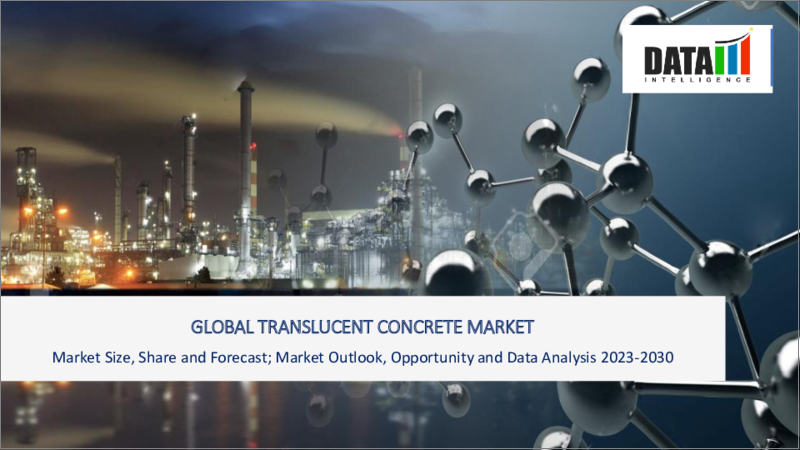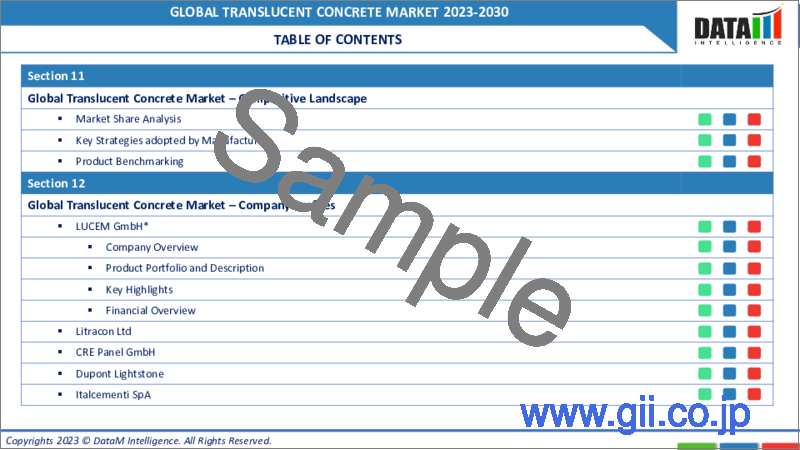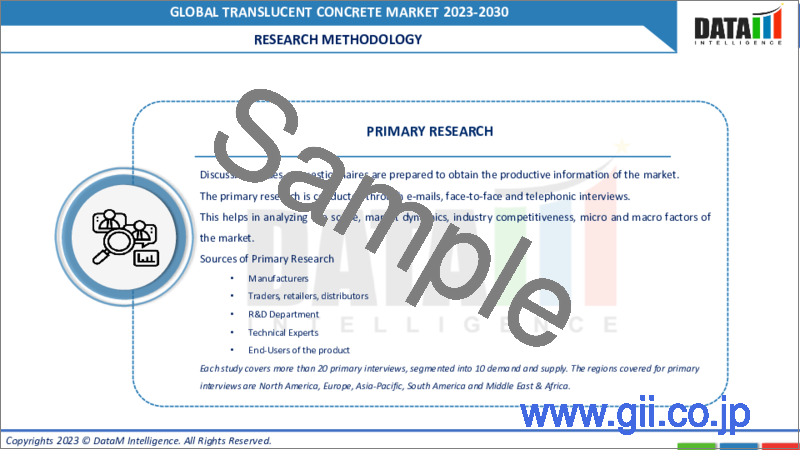|
|
市場調査レポート
商品コード
1255863
光透過コンクリートの世界市場-2023-2030Global Translucent Concrete Market - 2023-2030 |
||||||
|
● お客様のご希望に応じて、既存データの加工や未掲載情報(例:国別セグメント)の追加などの対応が可能です。 詳細はお問い合わせください。 |
|||||||
| 光透過コンクリートの世界市場-2023-2030 |
|
出版日: 2023年04月11日
発行: DataM Intelligence
ページ情報: 英文 187 Pages
納期: 約2営業日
|
- 全表示
- 概要
- 目次
市場概要
世界の光透過コンクリート市場は、予測期間(2023-2030年)に51.5%のCAGRで成長する見通しです。
光透過コンクリートは、光ファイバーなどの光学素子を埋め込むことで透過性を持たせた建築材料です。光ファイバーは、屋根、壁、床などの片側からもう片側へ光を運ぶコンクリートで使用されます。光はコンクリートブロックの中を、光ファイバーはコンクリートパネルの中を通過します。光ファイバーの構造に依存し、光ファイバーを通過した光は、コンクリートの壁を通過するために壁に落ち、壁の別の側に光のパターンを作成します。
市場力学
都市化の進展、個人消費力の向上、建築物の美観・装飾性への要求の高まり、省エネルギーへの要求の高まり
光透過コンクリートは地下鉄の屋根材として多く使用されており、消費エネルギーは日中の地下鉄の照明システムの電源として使用され、市場の成長をさらに後押ししています。住宅、商業ビル、レストランの床材、鉄道の床材、庭の遊歩道、階段などの床材用途で光透過コンクリートの使用が増加していること。都市化の進展、消費者の消費力の向上、美観や装飾性に優れた建物への需要の増加、省エネルギーへのニーズの高まりなどが、光透過コンクリートへの需要を後押ししています。
光透過コンクリートはコストが高い
光透過コンクリートが高価な理由のひとつに、製造工程の複雑さが挙げられます。光透過コンクリートは、原料を特定の方法で混合し、光が通るようにコンクリートを打設するという特殊な方法で製造されます。それぞれの工程は、従来のコンクリート製造よりも複雑で時間がかかるため、最終製品のコストが高くなります。
COVID-19の影響度分析
COVID-19分析では、COVID前シナリオ、COVIDシナリオ、COVID後シナリオに加え、価格力学(パンデミック時やCOVID前シナリオとの比較による価格変動を含む)、需要-供給スペクトラム(取引制限、封鎖、その後の問題による需要と供給のシフト)、政府の取り組み(政府機関による市場、セクター、産業の活性化に関する取り組み)、メーカーの戦略的取り組み(COVID問題を軽減するためのメーカーの取り組み)についても解説しています。
目次
第1章 調査手法とスコープ
- 調査手法
- 調査目的および調査範囲について
第2章 定義と概要
第3章 エグゼクティブサマリー
- 原材料別スニペット
- アプリケーション別スニペット
- エンドユーザー別スニペット(Snippet by End-User
- 地域別スニペット
第4章 市場力学
- 影響要因
- 促進要因
- 環境配慮型物質の採用が進み、設置する商品の美観が求められるようになった
- 抑制要因
- 光透過コンクリートの高コスト
- 機会
- 影響度分析
- 促進要因
第5章 産業分析
- ポーターのファイブフォース分析
- サプライチェーン分析
- 価格アナリシス
- レギュラトリー・アナリシス
第6章 COVID-19の分析
- COVID-19の解析について
- COVID-19シナリオ前
- 現在のCOVID-19シナリオ
- ポストCOVID-19またはフューチャーシナリオ
- COVID-19における価格ダイナミクス
- 需給スペクトル
- パンデミック時の市場に関連する政府の取り組み
- メーカーの戦略的な取り組み
- 結論
第7章 原材料別
- コンクリート
- 光学素子
第8章 アプリケーション別
- ファサード
- ウォールクラッディング
- フローリング
- ルーフィング
- その他
第9章 エンドユーザー別
- インダストリアル
- 住宅用
- コマーシャル
第10章 地域別
- 北米
- 米国
- カナダ
- メキシコ
- 欧州
- ドイツ
- 英国
- フランス
- イタリア
- ロシア
- その他欧州
- 南米
- ブラジル
- アルゼンチン
- その他南米地域
- アジア太平洋地域
- 中国
- インド
- 日本
- オーストラリア
- その他アジア太平洋地域
- 中東・アフリカ地域
第11章 競合情勢について
- 競合シナリオ
- 市況分析・シェア分析
- M&A分析
第12章 企業プロファイル
- LUCEM GmbH
- 会社概要
- 製品ポートフォリオと説明
- 財務概要
- 主な展開
- Litracon Ltd
- CRE Panel GmbH
- Dupont Lightstone
- Italcementi SpA
- LCT GesmbH
- Pan-United Corporation Ltd.
- Beton Broz
- Florack Bauunternehmung GmBH
- Glass block technology limited
第13章 付録
Market Overview
The global translucent concrete market reached US$ XX million in 2022 and is projected to witness lucrative growth by reaching up to US$ XX million by 2030. The market is growing at a CAGR of 51.5% during the forecast period (2023-2030).
Transparent concrete is a building material with transmissive properties owing to embedded light optical elements, usually optical fibers. The optical fibers are used in the concrete carrying light from one side of the roof, wall or floor to the other end. The light should pass through the concrete block and optical fiber through the concrete panel. It depends on the structure of the optical fibers and the light passed through optical fibers falls on the wall to pass through the concrete wall, creating a light pattern on another side of the wall.
Market Dynamics
Increased urbanization, increased consumer spending power, increased demand for aesthetically pleasing and decorative buildings, and increased need for energy conservation
The translucent concrete is largely used as subway roofing, where energy consumption is used to power the subway's lighting system during the day, further propelling the market growth. The increasing use of translucent concrete in flooring applications such as residential buildings, commercial buildings, restaurant floorings, railway floorings, walking tracks in gardens and staircases. Increased urbanization, increased consumer spending power, increased demand for aesthetically pleasing and decorative buildings, and increased need for energy conservation are all driving demand for transparent concrete.
The high cost of translucent concrete
One of the reason for the high cost of translucent concrete is the complexity of the manufacturing process. Translucent concrete is made with a special method that involves mixing the raw materials in a specific way and casting the concrete in a specific way to ensure that light can pass through. The respective process is more complex and time-consuming than traditional concrete manufacturing, which increases the cost of the final product.
COVID-19 Impact Analysis
The COVID-19 Analysis includes Pre-COVID Scenario, COVID Scenario and Post-COVID Scenario along with Pricing Dynamics (Including pricing change during and post-pandemic comparing it with pre-COVID scenarios), Demand-Supply Spectrum (Shift in demand and supply owing to trading restrictions, lockdown and subsequent issues), Government Initiatives (Initiatives to revive market, sector or Industry by Government Bodies) and Manufacturers Strategic Initiatives (What manufacturers did to mitigate the COVID issues will be covered here).
Segment Analysis
The global translucent concrete market is segmented based on raw material, application, end-user and region.
The increasing use of translucent concrete in architectural and lighting design projects
One of the main advantages of using optical elements in translucent concrete is that they allow for greater control over light transmission. Lenses, for example, can be used to focus light in specific areas, while mirrors can be used to reflect light in different directions. Thus, allowing for more precise control over the lighting effect, creating a more dynamic and visually appealing result. As architects and designers look for ways to incorporate natural light into their projects in a more precise and visually appealing way, the demand for optical elements in translucent concrete will likely continue to grow.
Geographical Analysis
The strong presence of major players coupled with the massive demand for this organic compound in direct & intermediate chemical formulations in various industries
In the flourishing construction industry, the demand for optical elements, plasterboard and wallboard is also substantially increasing, which is anticipated to drive the translucent concrete market in Asia-Pacific during the forecast period.
Additionally, many international and packaging developing companies are based in the Asia-Pacific, so it is expected to influence the translucent concrete market. The innovation regarding power generation, transportation, flooring and roofing in the translucent concrete market is set to develop in the future.
Competitive Landscape
The major global players in the market include: LUCEM GmbH, Litracon Ltd, CRE Panel GmbH, Dupont Lightstone, Italcementi SpA, LCT GesmbH, Pan-United Corporation Ltd, Beton Broz, Florack Bauunternehmung GmBH and Glass block technology limited.
Why Purchase the Report?
- To visualize the global translucent concrete market segmentation based on raw material, application, end-user and region, as well as understand key commercial assets and players.
- Identify commercial opportunities by analyzing trends and co-development.
- Excel data sheet with numerous data points of translucent concrete market-level with all segments.
- PDF report consists of a comprehensive analysis after exhaustive qualitative interviews and an in-depth study.
- Product mapping available as excel consisting of key products of all the major players.
The global translucent concrete market report would provide approximately 61 tables, 57 figures and 187 Pages.
Target Audience 2023
- Manufacturers/ Buyers
- Industry Investors/Investment Bankers
- Research Professionals
- Emerging Companies
Table of Contents
1. Methodology and Scope
- 1.1. Research Methodology
- 1.2. Research Objective and Scope of the Report
2. Definition and Overview
3. Executive Summary
- 3.1. Snippet by Raw Material
- 3.2. Snippet by Application
- 3.3. Snippet by End-User
- 3.4. Snippet by Region
4. Dynamics
- 4.1. Impacting Factors
- 4.1.1. Drivers
- 4.1.1.1. The rising adoption of environmentally beneficial substances and the need for aesthetical commodities for installation
- 4.1.1.2. XX
- 4.1.2. Restraints
- 4.1.2.1. The high cost of translucent concrete
- 4.1.2.2. XX
- 4.1.3. Opportunity
- 4.1.3.1. XX
- 4.1.4. Impact Analysis
- 4.1.1. Drivers
5. Industry Analysis
- 5.1. Porter's Five Forces Analysis
- 5.2. Supply Chain Analysis
- 5.3. Pricing Analysis
- 5.4. Regulatory Analysis
6. COVID-19 Analysis
- 6.1. Analysis of COVID-19
- 6.1.1. Before COVID-19 Scenario
- 6.1.2. Present COVID-19 Scenario
- 6.1.3. Post COVID-19 or Future Scenario
- 6.2. Pricing Dynamics Amid COVID-19
- 6.3. Demand-Supply Spectrum
- 6.4. Government Initiatives Related to the Market During Pandemic
- 6.5. Manufacturers Strategic Initiatives
- 6.6. Conclusion
7. By Raw Material
- 7.1. Introduction
- 7.1.1. Market Size Analysis and Y-o-Y Growth Analysis (%), By Raw Material
- 7.1.2. Market Attractiveness Index, By Raw Material
- 7.2. Concrete*
- 7.2.1. Introduction
- 7.2.2. Market Size Analysis and Y-o-Y Growth Analysis (%)
- 7.3. Optical Elements
8. By Application
- 8.1. Introduction
- 8.1.1. Market Size Analysis and Y-o-Y Growth Analysis (%), By Application
- 8.1.2. Market Attractiveness Index, By Application
- 8.2. Facade*
- 8.2.1. Introduction
- 8.2.2. Market Size Analysis and Y-o-Y Growth Analysis (%)
- 8.3. Wall Cladding
- 8.4. Flooring
- 8.5. Roofing
- 8.6. Others
9. By End-User
- 9.1. Introduction
- 9.1.1. Market Size Analysis and Y-o-Y Growth Analysis (%), By End-User
- 9.1.2. Market Attractiveness Index, By End-User
- 9.2. Industrial*
- 9.2.1. Introduction
- 9.2.2. Market Size Analysis and Y-o-Y Growth Analysis (%)
- 9.3. Residential
- 9.4. Commercial
10. By Region
- 10.1. Introduction
- 10.1.1. Market Size Analysis and Y-o-Y Growth Analysis (%), By Region
- 10.1.2. Market Attractiveness Index, By Region
- 10.2. North America
- 10.2.1. Introduction
- 10.2.2. Key Region-Specific Dynamics
- 10.2.3. Market Size Analysis and Y-o-Y Growth Analysis (%), By Raw Material
- 10.2.4. Market Size Analysis and Y-o-Y Growth Analysis (%), By Application
- 10.2.5. Market Size Analysis and Y-o-Y Growth Analysis (%), By End-User
- 10.2.6. Market Size Analysis and Y-o-Y Growth Analysis (%), By Country
- 10.2.6.1. U.S.
- 10.2.6.2. Canada
- 10.2.6.3. Mexico
- 10.3. Europe
- 10.3.1. Introduction
- 10.3.2. Key Region-Specific Dynamics
- 10.3.3. Market Size Analysis and Y-o-Y Growth Analysis (%), By Raw Material
- 10.3.4. Market Size Analysis and Y-o-Y Growth Analysis (%), By Application
- 10.3.5. Market Size Analysis and Y-o-Y Growth Analysis (%), By End-User
- 10.3.5.1. Germany
- 10.3.5.2. UK
- 10.3.5.3. France
- 10.3.5.4. Italy
- 10.3.5.5. Russia
- 10.3.5.6. Rest of Europe
- 10.4. South America
- 10.4.1. Introduction
- 10.4.2. Key Region-Specific Dynamics
- 10.4.3. Market Size Analysis and Y-o-Y Growth Analysis (%), By Raw Material
- 10.4.4. Market Size Analysis and Y-o-Y Growth Analysis (%), By Application
- 10.4.5. Market Size Analysis and Y-o-Y Growth Analysis (%), By End-User
- 10.4.5.1. Brazil
- 10.4.5.2. Argentina
- 10.4.5.3. Rest of South America
- 10.5. Asia-Pacific
- 10.5.1. Introduction
- 10.5.2. Key Region-Specific Dynamics
- 10.5.3. Market Size Analysis and Y-o-Y Growth Analysis (%), By Raw Material
- 10.5.4. Market Size Analysis and Y-o-Y Growth Analysis (%), By Application
- 10.5.5. Market Size Analysis and Y-o-Y Growth Analysis (%), By End-User
- 10.5.5.1. China
- 10.5.5.2. India
- 10.5.5.3. Japan
- 10.5.5.4. Australia
- 10.5.5.5. Rest of Asia-Pacific
- 10.6. Middle East and Africa
- 10.6.1. Introduction
- 10.6.2. Key Region-Specific Dynamics
- 10.6.3. Market Size Analysis and Y-o-Y Growth Analysis (%), By Raw Material
- 10.6.4. Market Size Analysis and Y-o-Y Growth Analysis (%), By Application
- 10.6.5. Market Size Analysis and Y-o-Y Growth Analysis (%), By End-User
11. Competitive Landscape
- 11.1. Competitive Scenario
- 11.2. Market Positioning/Share Analysis
- 11.3. Mergers and Acquisitions Analysis
12. Company Profiles
- 12.1. LUCEM GmbH*
- 12.1.1. Company Overview
- 12.1.2. Product Portfolio and Description
- 12.1.3. Financial Overview
- 12.1.4. Key Developments
- 12.2. Litracon Ltd
- 12.3. CRE Panel GmbH
- 12.4. Dupont Lightstone
- 12.5. Italcementi SpA
- 12.6. LCT GesmbH
- 12.7. Pan-United Corporation Ltd.
- 12.8. Beton Broz
- 12.9. Florack Bauunternehmung GmBH
- 12.10. Glass block technology limited
LIST NOT EXHAUSTIVE
13. Appendix
- 13.1. About Us and Service
- 13.2. Contact Us




